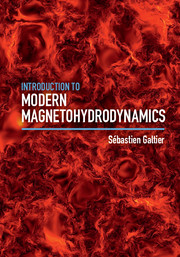Book contents
- Frontmatter
- Dedication
- Contents
- Preface
- Table of Physical Quantities
- Part I Foundations
- Part II Fundamental Processes
- Part III Instabilities and Magnetic Confinement
- 8 Static Equilibrium
- 9 Linear Perturbation Theory
- 10 Study of MHD Instabilities
- Exercise for Part III
- Part IV Turbulence
- Appendix 1 Solutions to the Exercises
- Appendix 2 Formulary
- References
- Index
9 - Linear Perturbation Theory
from Part III - Instabilities and Magnetic Confinement
Published online by Cambridge University Press: 13 October 2016
- Frontmatter
- Dedication
- Contents
- Preface
- Table of Physical Quantities
- Part I Foundations
- Part II Fundamental Processes
- Part III Instabilities and Magnetic Confinement
- 8 Static Equilibrium
- 9 Linear Perturbation Theory
- 10 Study of MHD Instabilities
- Exercise for Part III
- Part IV Turbulence
- Appendix 1 Solutions to the Exercises
- Appendix 2 Formulary
- References
- Index
Summary
When a static equilibrium has been found (see Chapter 8), the next question that we have to address concerns the stability of this equilibrium. A part of the answer is given by the linear perturbation theory, which consists of analyzing the result of a small (i.e. linear) perturbation of the equilibrium. If the equilibrium is stable, the perturbation will behave as a wave that propagates in the medium; if it is unstable, the perturbation will increase exponentially.
Instabilities
Classification
In Figure 9.1, we present some unstable and stable situations arising from the example of a sphere placed in an external potential field. In case 1 a sphere is at the bottom of a well of infinite potential. In this position the sphere can only perform oscillations around its equilibrium position. These oscillations, once generated, are damped due to friction until the sphere reaches a static equilibrium position at the bottom of the potential well. This is a situation of stable equilibrium. In case 2 a sphere is placed a the top of a potential (a hill). In this case, a small displacement of the sphere is sufficient to move it to much lower potentials: this is an unstable situation that is often associated with a linear instability. The third case is that of a metastable state where the sphere is placed initially on a locally flat potential (a plateau): a small displacement around the initial position does not change the potential of the sphere. Finally, the last case (case 4) is that of a sphere placed in a hollow. This is an example of non-linear instability: the sphere is stable against small perturbations but becomes unstable for larger disturbances.
In plasma physics, the sphere in the previous paragraph corresponds to a particular mode of a wave and the shape of the potential can be a source of free energy. There are many energy sources in space plasmas. For example, the solar wind is a continuous source of energy for the Earth's magnetospheric plasma
which is never in a static equilibrium. The consequences of this energy input are the generation of large-scale gradients and the deformation of the distribution functions of particles at small scales.
Information
- Type
- Chapter
- Information
- Introduction to Modern Magnetohydrodynamics , pp. 125 - 138Publisher: Cambridge University PressPrint publication year: 2016
